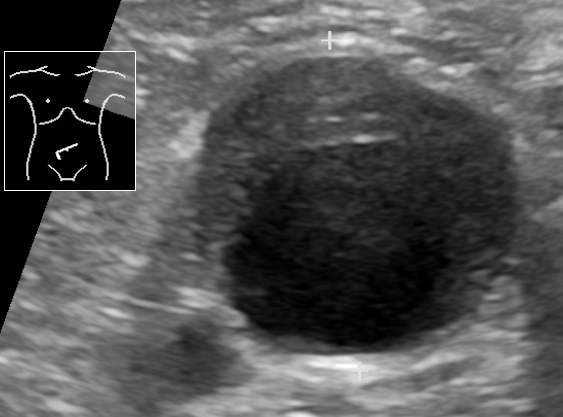An aortic aneurysm is the abnormal dilation of a segment of the aorta. Abdominal aortic aneurysm is the most common aortic aneurysm, occurring frequently in the infrarenal area. Degenerative aortic disorders are the prevalent etiology, affecting patients > 60 years of age. Most aneurysms are asymptomatic, but can cause compression of surrounding structures or rupture, which is a life-threatening emergency. Diagnosis is often made by ultrasound. As aneurysmal rupture carries a high mortality rate, surveillance is recommended for asymptomatic cases to monitor aortic diameter. Elective surgery (the majority via endovascular aortic repair) is an effective way to reduce complications and aneurysm-related death. This surgery is performed based on aortic size, underlying condition, and associated symptoms.
Last updated: Apr 14, 2025
Abdominal ultrasound:
Abdominal computed tomography (CT) with contrast:
Magnetic resonance imaging (MRI):
Arteriography:

Ultrasound showing an abdominal aortic aneurysm with a mural thrombus
Image: “Ultrasonography of abdominal aortic aneurysm with mural thrombus” by Mikael Häggström, M.D.. License: Public DomainManagement may vary based on practice location. The following information is based on US and European guidelines.
| AAA AAA An aortic aneurysm is the abnormal dilation of a segment of the aorta. Abdominal aortic aneurysm is the most common aortic aneurysm, occurring frequently in the infrarenal area. Most aneurysms are asymptomatic, but can cause compression of surrounding structures or rupture, which is a life-threatening emergency. Abdominal Aortic Aneurysms management of asymptomatic patients Patients Individuals participating in the health care system for the purpose of receiving therapeutic, diagnostic, or preventive procedures. Clinician–Patient Relationship (US)*[12] | AAA AAA An aortic aneurysm is the abnormal dilation of a segment of the aorta. Abdominal aortic aneurysm is the most common aortic aneurysm, occurring frequently in the infrarenal area. Most aneurysms are asymptomatic, but can cause compression of surrounding structures or rupture, which is a life-threatening emergency. Abdominal Aortic Aneurysms size |
|---|---|
| Rescreen after 10 years | ≥ 2.5 cm but < 3 cm |
| Imaging every 3 years | 3–3.9 cm |
| Imaging every 12 months | 4–4.9 cm |
| Imaging every 6 months | 5–5.4 cm |
| Consider elective repair | ≥ 5.5 cm Consider repair if ≥ 5 cm in women; expansion of < 0.5 cm/6 months or > 1 cm/1 year; associated femoral, iliac, popliteal aneurysm Popliteal aneurysm Extremity and Visceral Aneurysms, or PAD requiring revascularization Revascularization Thromboangiitis Obliterans (Buerger Disease) |
Operative options:[4,5,8]
Indications for operative repair:[5,12‒14]

Management of symptomatic/ruptured abdominal aortic aneurysm: 30-30-30 rule[12]
ABCs: airway, breathing, and circulation
EVAR: endovascular aortic repair
H/P: history and physical exam
rAAA: ruptured abdominal aortic aneurysm
30-30-30 rule:
Time from entering emergency department until intervention should be 90 minutes:
Access cardiopulmonary status:
Medical treatment (US dosing):[14]
| Class I | Class II | Class III | Class IV | |
|---|---|---|---|---|
| Percentage of blood loss | < 15 | 15–30 | 30–40 | > 40 |
| Pulse rate | Normal | 100–120 | 120–140 | > 140 |
| Blood pressure | Normal | Normal | ↓ | Significantly ↓ |
| Pulse pressure | Normal | ↓ | ↓ | ↓ |
| Respiratory rate Respiratory rate The number of times an organism breathes with the lungs (respiration) per unit time, usually per minute. Pulmonary Examination | 14–20 | 20–30 | 30–40 | > 35 |
| Mental status | Slightly anxious | Mildly anxious | Anxious, confused | Confused, lethargic |
| Urine output (mL/hr) | > 30 | 20–30 | 5–15 | Minimal |
| Fluid resuscitation Resuscitation The restoration to life or consciousness of one apparently dead. . Neonatal Respiratory Distress Syndrome strategy | Crystalloid Crystalloid Isotonic solutions of mineral salts, such as ringer’s lactate and sodium chloride (saline solution), used in fluid therapy to rehydrate blood volume. Intravenous Fluids | Crystalloid Crystalloid Isotonic solutions of mineral salts, such as ringer’s lactate and sodium chloride (saline solution), used in fluid therapy to rehydrate blood volume. Intravenous Fluids, possibly blood products | Type-specific blood | Massive transfusion protocol |
References